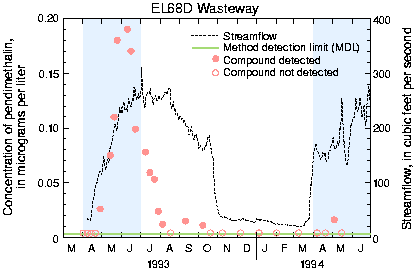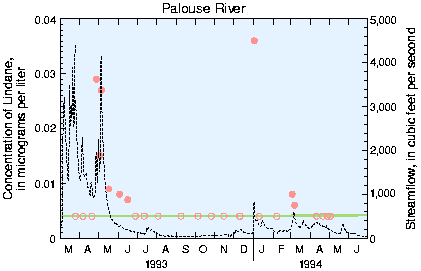Thirty-one surface-water sites representing agricultural land use with different crops, irrigation methods, and other agricultural practices were sampled for pesticides. Pesticides were detected in samples from all sites except for Palouse River at Laird Park, a headwaters site in a forested area (see map, p. 24). Pesticide detections are usually related to pesticide applications (fig. 23) but are also influenced by agricultural practices, such as the rate of application, the rate at which the pesticide breaks down in the soil and water, and the ability of the pesticide to dissolve and be transported by water (fig. 24).

Figure 23. In the Quincy-Pasco subunit, concentrations of pendimethalin are highest during or shortly after reported periods of application, April to June (shaded areas).

Figure 24. In the Palouse subunit, concentrations of gamma-HCH (Lindane) are highest during periods of storm runoff [2, 22]; gamma-HCH is not applied to crops but is registered for use as a livestock spray and as a seed treatment.
Many pesticides were detected in surface water at very low concentrations. Concentrations of six pesticides in one or more surface-water samples exceed freshwater-chronic criteria for the protection of aquatic life in some samples (fig. 25). No pesticide concentrations exceed drinking water standards (however, surface water is not a drinking water source in the Central Columbia Plateau).
Figure 25. Concentrations of six pesticides (mostly insecticides) in surface water sometimes exceed guidelines for the protection of aquatic life. No concentrations exceed existing drinking water standards (see p. 26).